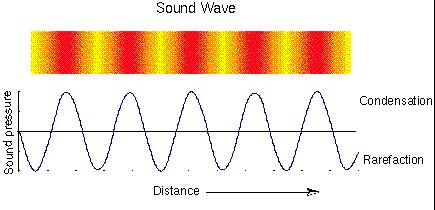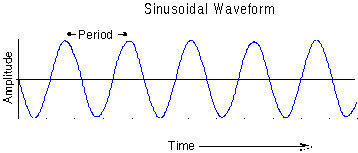
1. The nature of sound
Sound is variations in air pressure detectable by the human ear. Pressure varies through time at a particular point, and over space at a particular time, as molecules of air collide (condensation) or move apart (rarefaction).

2. Waves and energy
Movement, or variation at a particular point, can be plotted as a waveform on a graph, as in Fig. 1.
N.B. (i) The relation of waveform to molecule movement.
(iii) Possibility of discrete sampling to represent waveform (see e.g. Johnson p. 23).
The amplitude (the amount of maximum displacement from zero) of the wave reflects the highest pressure involved, and therefore the acoustic energy. N.B. Amplitude is not connected to frequency.
Relations between frequency (F), period (P), wavelength (w) and speed of sound (c):
For example, a wave with a period of 1/100th of a second has a frequency of F = 1/0.01 = 100 Hz (Hertz = cycles per second)
w = c/F
The standard speed of sound is 330 m/s (331.3 m/s at room temperature, in fact).
For example, a wave with a frequency of 100Hz has a wavelength of 330/100 = 3.3 m
Fig. 2: 
3. Types of sound sources
a. Tuning fork - periodic
b. Vowel sounds - quasi-periodic. Fig. 3:
c. Flow of water - continuous random noise
d. Fricative - random within certain constraints. Fig. 4: 
e. Hammer hitting table - transient
f. Stop consonant - transient + noise. Fig. 5: